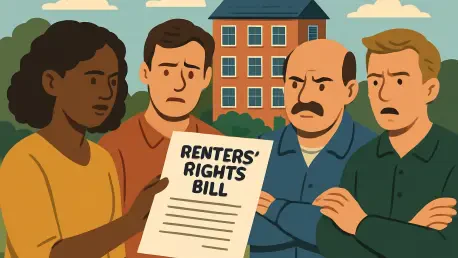The private rental sector in the UK stands on the brink of a monumental transformation with the impending enactment of the Renters’ Rights Bill, heralding the most significant policy overhaul in nearly four decades. For landlords, this legislation is a double-edged sword: it promises to enhance tenant security by addressing deep-rooted issues of tenancy instability, but it also introduces a complex array of financial, operational, and legal challenges. As the balance of power shifts toward tenants, property owners must grapple with a rapidly changing landscape that could reshape their business models. This guide seeks to demystify the key components of the Bill, shedding light on its implications and providing actionable strategies for landlords to not only comply with the new rules but also thrive amidst the reforms.
Grasping the Legislative Shift
Unpacking Tenant Protections
The Renters’ Rights Bill fundamentally alters the dynamics of the landlord-tenant relationship by prioritizing tenant security through several groundbreaking provisions. One of the most notable changes is the abolition of Section 21 ‘no-fault’ evictions, meaning landlords can no longer terminate tenancies without a valid reason. Instead, they must use Section 8 notices, citing specific grounds such as rent arrears or tenant misconduct. Additionally, fixed-term leases are being phased out in favor of assured periodic tenancies, allowing tenants month-to-month flexibility while diminishing landlords’ ability to forecast long-term occupancy. These measures aim to empower tenants but introduce a level of uncertainty for property owners who have relied on predictable tenancy terms.
Beyond eviction reforms, the Bill imposes strict limits on rent adjustments and notice periods, further tilting the balance toward tenant rights. Rent increases are now capped at once per year, preventing landlords from adapting swiftly to market fluctuations or rising costs. Moreover, if a landlord intends to sell the property or move back in, a four-month notice period is mandatory—twice the two-month notice tenants are required to provide when vacating. This disparity can create logistical challenges, as landlords may find themselves locked into extended timelines while tenants retain greater flexibility. Understanding these provisions is essential for anticipating the operational adjustments needed to stay compliant.
Financial and Administrative Pressures
The financial implications of the Renters’ Rights Bill are a pressing concern for landlords, particularly those managing smaller portfolios with limited resources. Extended notice periods and the potential for legal disputes over possession claims through tribunals can significantly disrupt cash flow. For instance, a delayed eviction process due to contested Section 8 notices could leave a property unoccupied for months, straining budgets already stretched by mortgage payments or unexpected repairs. This unpredictability poses a stark challenge for landlords who depend on consistent rental income to maintain their investments, forcing many to reassess their financial strategies.
On top of financial hurdles, the administrative burden introduced by the Bill adds another layer of complexity to property management. New compliance requirements, such as those under Awaab’s Law, mandate rapid responses to maintenance issues within tight deadlines, increasing both operational costs and legal risks. The shift to rolling tenancies and the need to substantiate eviction grounds also mean a surge in paperwork and time spent navigating regulatory requirements. For landlords unaccustomed to such demands, these changes can feel overwhelming, potentially necessitating external support or revised internal processes to ensure adherence to the law without sacrificing efficiency.
Market Dynamics and Forward-Looking Solutions
Rising Repossessions and Housing Strain
A troubling trend emerging in the wake of the Renters’ Rights Bill is the growing number of landlords exiting the private rental market, a move that threatens to exacerbate the UK’s ongoing housing crisis. Recent data reveals a 6.8% national increase in landlord repossessions, with some regions experiencing spikes exceeding 2,500%, as property owners take preemptive action to protect their investments ahead of the full implementation of reforms. This wave of repossessions reflects a broader sentiment of uncertainty, as many landlords question the long-term viability of their portfolios under the new regulatory framework. The shrinking supply of rental properties could have far-reaching consequences for an already strained market.
Compounding this issue is the stark reality faced by vulnerable families, with government figures indicating over 81,000 households with children currently in temporary accommodation—a 13.7% rise from previous levels. Over 90% of letting agents express concern about further landlord exits, foreseeing a ripple effect that could overburden local authorities tasked with finding alternative housing solutions. As rental stock diminishes, the pressure on public resources intensifies, highlighting the unintended consequences of the Bill’s stringent measures. Landlords must recognize their role within this broader ecosystem, as their decisions to stay or leave the market carry significant societal implications.
Embracing Collaborative Innovations
Amid the challenges posed by the Renters’ Rights Bill, innovative partnerships offer a promising avenue for landlords to adapt and sustain profitability. Specialist property management firms are stepping in as valuable allies, providing guaranteed rental income through long-term tenancy agreements that remain unaffected by tenant turnover or vacancies. These arrangements can span multiple years, offering landlords a stable revenue stream while mitigating the risks associated with rolling tenancies and extended notice periods. Such solutions are particularly appealing for those seeking to minimize financial uncertainty in an increasingly regulated environment.
In addition to income guarantees, these firms often deliver comprehensive management services at no extra cost, alleviating much of the administrative burden introduced by the new legislation. From tenant onboarding and regular property inspections to 24/7 maintenance support and protection against malicious damage, these services enable landlords to focus on strategic oversight rather than day-to-day operations. Importantly, this model also aligns with the Bill’s overarching goal of enhancing tenant welfare, as many of these firms prioritize rehousing vulnerable families. By partnering with such organizations, landlords can contribute to societal good while safeguarding their own interests, creating a mutually beneficial framework for navigating the reforms.









